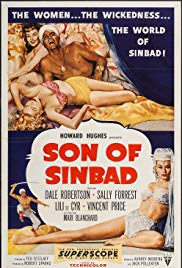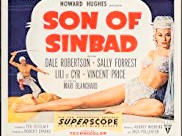Son of Sinbad ** (1955, Dale Robertson, Vincent Price, Sally Forrest, Lili St Cyr, Mari Blanchard) – Classic Movie Review 7591
Director Ted Tetzlaff’s kitsch and colourful adventure 1955 Son of Sinbad stars easy-going Dale Robertson as Sinbad’s son, also known as Sinbad, but he is inevitably upstaged by scene-stealing Vincent Price as his friend Omar Khayham the tent-maker, poet and cynic with a fine line in cutting remarks but remarkably few cutting gestures.
Written by Aubrey Wisberg and Jack Pollexfen, Son of Sinbad is low on story: Sinbad saves Baghdad, frolics with Ameer (Sally Forrest), Nerissa (Lili St Cyr) and Kristina (Mari Blanchard), and sports a dashing line in hooped earrings and baggy trousers.
But forget the thin plot and the stock characters, and instead watch out for William Snyder’s lush Technicolor cinematography and the seemingly endless display of scantily-clad starlets who wiggle their torsos through every major scene of the film. That might have been due to the tastes of amorous billionaire producer Howard Hughes, a fan of lovely young starlets.
Thanks to the scantily-clad starlets wiggling their torsos, the film was condemned by the Catholic Legion of Decency, which of course did it no harm at all at the box-office, leading many more people to go out and see it.
Also in the cast are Leon Askin, Jay Novello, Raymond Greenleaf, Ian MacDonald, Donald Randolph, Larry Blake, Edwina Hazard, John Merton, Woody Strode and Gus Schilling.
Son of Sinbad is directed by Ted Tetzlaff, runs minutes (edited) , is made and released by RKO Radio Pictures, is written by Aubrey Wisberg and Jack Pollexfen, is shot in Technicolor by William Snyder, is produced by Howard Hughes and Robert Sparks, is scored by Victor Young and Constantin Bakaleinikoff, and is designed by Albert S D’Agostino.
Typically of Hughes at RKO, it was filmed in 1953 but released in 1955. It is shot in 3D, but by 1955 the 3D craze had faded and widescreen was the rage, so it was converted to Superscope by cropping the top and bottom off the original standard ratio images. The TCM print has the RKO Radio Pictures Superscope logo though is the original uncropped 4:3 ratio film.
© Derek Winnert 2018 Classic Movie Review 7591
Check out more reviews on http://derekwinnert.com



